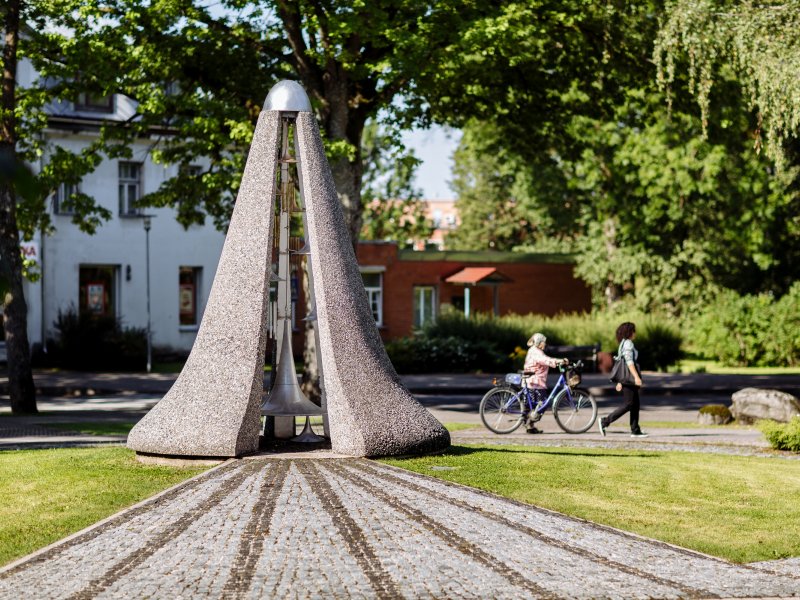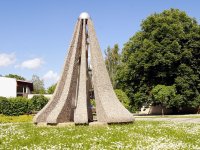
A sculpture created by sculptor Inta Berga called “The wind chimes”. It was inaugurated in 2007. Each of the eight chimes symbolizes a century in the history of the city of Sigulda. Let’s take a look at what’s happened in the past.
| Address | Pils iela, Sigulda |
| Coordinates | 57.154935 24.852921 |
| Phone | +371 67971335 |
| info@sigulda.lv | |
| www | www.tourism.sigulda.lv |
Our timeline starts in the year 1207 when Bishop Albert of Riga and the Order of the Brothers of the Sword were dividing the lands which formerly belonged to the Livs. This was also the same time when Venno, Master of the Order, began building Sigulda castle. On the opposite side of the Gauja valley two more castles, Krimulda and Turaida, were erected.
In the 14th century, the Livonian Order still governed in Sigulda. The castle, originally built as a castellum, was rebuilt and modified in the convent style. Merchant houses and other buildings slowly appeared in the area surrounding the castle.
In the 15th century, Sigulda is listed in documents as a town for the first time. More precisely, Sigulda was a merchant and craftsmen settlement located between the territory where Sigulda church and the ruins of Sigulda Medieval castle are today.
Sigulda was destroyed twice by Russian troops during the 16th century. After the Livonian war, Vidzeme (the Northern part of Latvia) became the property of Polish Lithuania. The city of Sigulda is brought back to life. Several documents precisely describe the look of the city at that time, the buildings and the people who lived there.
The transition from the 16th to the 17th century brings change and anxiety. The Polish-Swedish war begins. Vidzeme falls and remains under Swedish control for the next 100 years. The famous Sigulda legend of the Turaida Rose, Maija, unfolds during this time. To learn more about the love story and fate of the Turaids Rose, please visit Gutman's Cave located in Gauja primeval valley.
The 17th century brought changes to the nobility. The majority of the manor houses, including the Sigulda manor house, became state property. The Swedish government then rented them back to the nobility who, in turn, reduced their losses by exploiting local peasants and having them work for free. The first church school was also opened during this time.
The beginning of the 18th century brought the Northern War in which Russia and Sweden battled.
Sigulda and its district were forced to face hard times. Both peasant buildings and manor houses were destroyed. This war was immediately followed by another catastrophe - the Great Plague. The epidemic took many lives; only a quarter of the inhabitants in Sigulda district survived. After the war, Vidzeme became part of the Russian Empire. Sigulda manor house became the property of General Peter von Lasi whose heirs later sold it. After a series of legal actions, it was owned by the
von Borh family.
The 19th century, especially toward the end, marked itself in history as a time of resurgence for the once sparsely populated Sigulda. The work of the Kropotkin family also played a role in this restoration. One of the most remarkable events occurred in the middle of the century with the visit of the Tzar of Russia, Alexander II, which provided motivation for many improvements. Unfortunately, the first wooden bridge which crossed the Gauja river no longer exists, but you can still visit other reminders from that time: the Serpentine Road and the Emperor’s Seat!
Towards the end of the 19th century, the arrival of the railroad allowed easy accessibility to all visitors of which the majority came from Riga. Many villas and resorts were built. The attractions of Sigulda were advertised in Russian newspapers which significantly increased the number of tourists. By the beginning of the 20th century, Sigulda was a popular resort place second only to Jurmala. Unfortunately, the development of Sigulda was interrupted by WWI. Once again, multiple buildings were destroyed and interest to visit Sigulda waned. The situation improved after Latvia was established as a country and Siguldians, once again, we're able to manage their own economic and political affairs.
Sigulda, once a village, was now a city. Understandably, life in Sigulda again changed after WWII with the onset of a new administration with new rules. The city was rebuilt and again became popular.
The 20th century has been a time of dynamic change. Soviet administration was replaced when Latvia regained and established its independence. Dainu (Folk Song) Hill, symbolizing Latvian culture and strength opened in Turaida. The Latvian (red-white-red) flag is now flown from the tower of Sigulda castle. Sports, recreation centers, and ski runs have opened up one after another. Joining the European Union has created the possibility that Sigulda will become a renowned tourist attraction.
In 2007, Sigulda celebrated its 800th birthday. Guests came from all over the world. Siguldians flocked to the streets to celebrate; their cheers rang out and the pride and joy they have for their beautiful city could be seen in the glow of their eyes. You, too, are a welcome guest to Sigulda!















